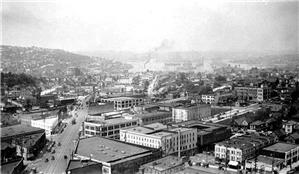On October 14, 1890, the Seattle City Council approves a “provisional” franchise for a new streetcar line between downtown and south Lake Union. Eight alternative routes are authorized with the final franchise to be awarded to the first company to establish service. The Seattle Electric Railway and Power Company, guided by Luther Henry Griffith (b. 1862), wins the race by laying track in just five days along today’s Westlake Avenue.
Steel Cable or Electric Wire?
Griffith and associates had previously won city franchises for streetcar lines along Western Avenue between Pike Street and Lake Union before joining forces with Frank Osgood’s Seattle Street Railway Company, which built the city’s first horse-drawn line in 1884. The new Seattle Electric Railway and Power Company inaugurated Seattle’s first electric service along 2nd Avenue on March 31, 1889, but it faced stiff competition from cable car lines serving 1st Avenue (then Front Street) and Yesler Way.
The city government was eager for a line to link the downtown with south Lake Union’s docks and lumber mills, and Seattle Electric Railway and the Front Street Cable Railway Company were equally eager to build what would be a heavily used and profitable route. Griffith proposed that the City approve a “provisional” franchise with the permanent franchise to be awarded to the first company to offer service.
Shortest Distance Between Two Points
The Front Street Cable Railway Company accepted the plan, not knowing that Griffith had quietly acquired 53 lots along the abandoned route of the Seattle Coal & Transportation Company’s narrow-gauge railway (Seattle’s first railroad) running diagonally between Pike Street and Lake Union’s south shore. The cable line, in contrast, planned to follow the established street grid and zigzag its way to the lake. According to transit historian Leslie Blanchard:
“One hundred men and nine gang plows tackled the construction job under Griffith’s personal supervision; and the cars were running out to the lake in the incredible time of five days. The cable company, dumbfounded by this terrific feat, made no attempt at building a competing line and, in fact, never did reach Lake Union.”
Seattle Electric Railway later extended its line to Fremont over a planked trestle hugging Lake Union’s western shore, and the line’s southern terminus at 4th Avenue and Pike Street became downtown Seattle’s major transit hub. We know the route today as Westlake Avenue, which was paved for mixed traffic in 1906. Westlake long marked the border between the two phases of the Denny Regrade, which was completed east of the boulevard between 1929 and 1931.
End of the Line
Streetcar and Interurban service on Westlake ended in the late 1930s and early 1940s with the shutdown of the city's streetrail system. Much later, Seattle Mayor Greg Nickels (b. 1955) and Paul Allen’s (1953-2018) Vulcan organization proposed to restore streetcar service more than a century after Griffith’s coup. Ground was broken to build the tracks for the new streetcar on July 7, 2006. About a year and a half later, on December 12, 2007, the new South Lake Union Streetcar began its first run from a point not far from Westlake Center to South Lake Union.

